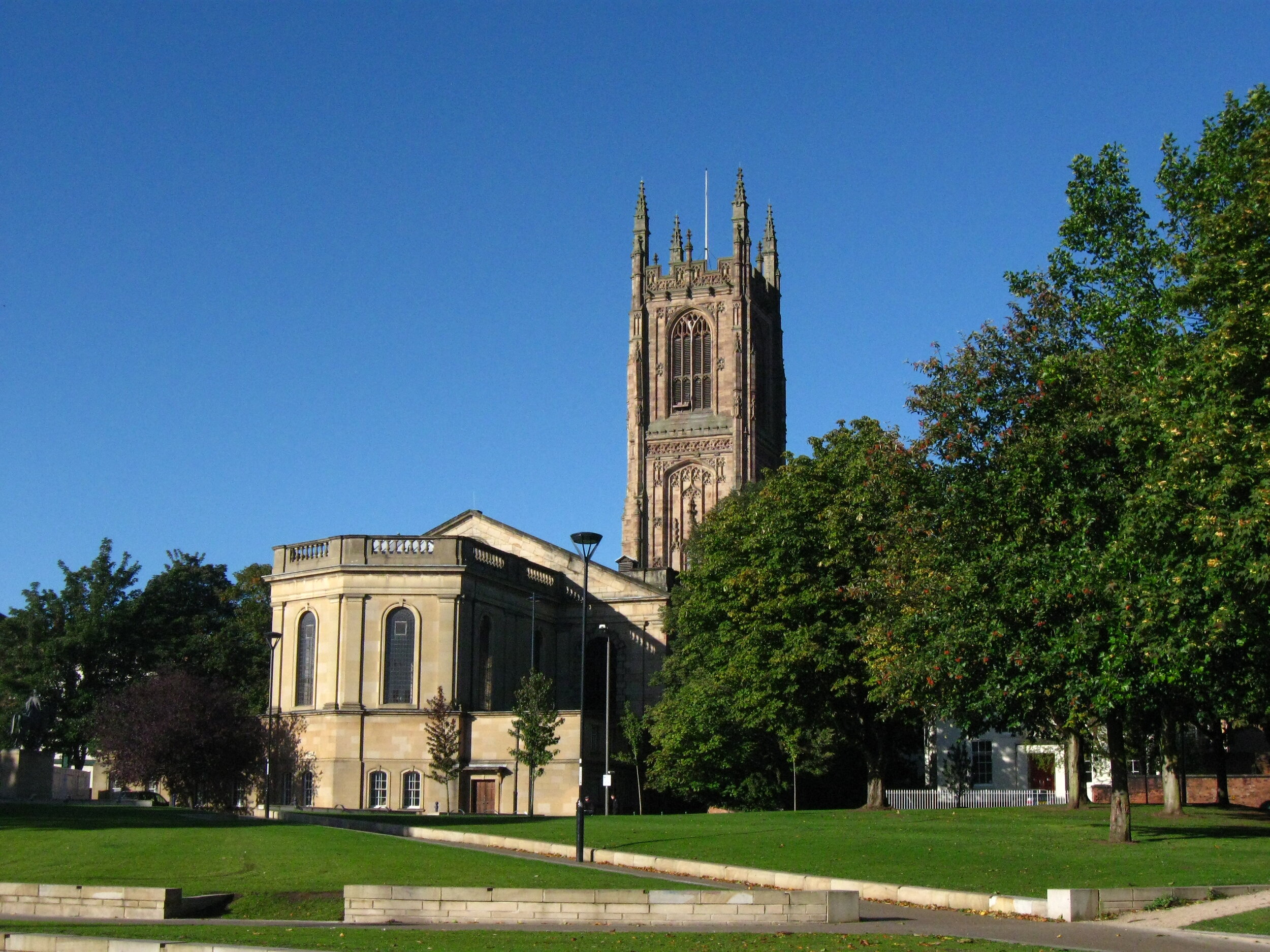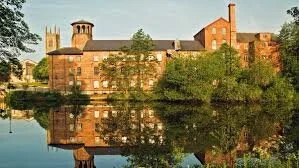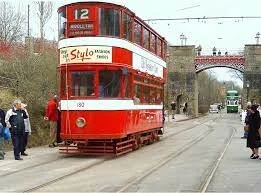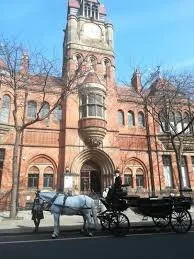
Derby
Pride Park. Home of Derby County
Derby Cathedral
Silk Mills
Crich Tramway Museum
Chatsworth House
Derby Museum
CITY:
Introduction:
Derby is the largest city and traditional county town of Derbyshire. It lies on the River Derwent in the East Midlands and has a population of 249,000.
Brief History:
The Romans were the first settlers in the Derby area. They built a first fort in 50 AD on the west side of the river and a newer one in 80 AD which they called Derventio. Possibly, civilians moved into the surrounding lands next to the forts to sell the soldiers their wares.
The Romans left their forts, and Britain, in 407 AD and the forts demised.
The Saxons may have moved back into the area in the 9th century but it was 873 AD when the Danes invaded England and formed the town of Derby, named after the Danish word Deor, which means Deer settlement.
The Saxons took the town in 917 and incorporated it into the kingdom of England. At the time of the Domesday Book the population was 2000 and there was a market where blacksmiths, coopers and carpenters carried out their trading.
In 1154 the town was granted a charter and a later one in 1204 allowed the inhabitants to run themselves and a guild was formed. Woollen, leather and brewing trades were started.
With prosperity priors and friars came to the town and a hospital was opened.
The population reached 3500.
Henry V111 got rid of the priors and friars but the tower of All Saints church was built. The town suffered plague twice in the 17th century.
Also in the 17th century clock making was commenced, a water supply system installed and the office of Mayor commenced.
By the 18th century Derby was a good size market town with the country’s first silk mill and the production of porcelain began. After visiting Derby the king agreed that a crown could be added to the porcelain and under Queen Victoria it became Royal Crown Derby, which survives until today.
The 19th century saw life gradually improve and gas street lighting, the railways, a swimming pool, Art School, library and museum made life more pleasant. Following these improvements came trams and electric lighting.
New industries included paint making, railway engines and iron foundries were commenced.
Exciting times lay ahead in the 20th century when Rolls Royce moved into Derby to construct cars and aircraft engines. Textiles were also important.
Major slum clearance was started and large estates were built to replace them.
On the down side a Zeppelin bombed Derby in 1916 and 5 people were killed and the second world war saw 74 citizens killed by bombing.
All Saints Church became a cathedral in 1927 and Derby became a city in 1977.
Later in the century Toyota opened a car plant and the local college became a University.
The 21st century saw an expansion of the retail sector.
Things to Do:
As an historic city you would expect to find much to do and you won’t be disappointed. The following are very much worth a visit:
Derby Cathedral: is located in Iron Gate in city centre. It has one of the highest perpendicular towers in the UK which if climbed gives spectacular views over four counties. Peregrine falcons nest in the tower and have successfully reared some chicks. The cathedral also contains the oldest “10 bells” in the world.
Check out the Bakewell Screen and the tomb of Bess of Hardwick.
Deby Museum: is a good visit where you can see works by local artist Joseph Wright, an Egyptian mummy and Crown Derby porcelain.
Silk Mills: is an interesting museum located on the first factory site in the world and is a UNESCO project. (Currently being renovated).
St. Mary’s Chapel on the Bridge: located in Sowter Road is one of only six bridge chapels left in Britain and is a hidden gem.
Crown Derby Factory Tour and Shop: in Osmaston Road is a fascinating place to see fine porcelain made and decorated. Discounts are available when buying in the shop.
Further afield in Derbyshire you can find Chatsworth House, Crich Tramway village, Donington Park, Alton Towers, Heights of Abraham and the Peak District.
Night Life:
Night clubs in the city are found in the Wardwick, Sadler Gate and Friar Gate area. Pubs are of course spread throughout the city centre and out to the suburbs and surrounding countryside. Many of these have bands and other music.
The Derby LIVE Guildhall Theatre located in Market Place puts on musicals, touring plays, rock bands and comedy nights. For information phone 01332 255800.
Derby Theatre in Theatre Walk is a modern venue which specialises in new and classic dramatic and comedy productions.
There are three cinema complexes, Odeon in the Meteor Centre on Mansfield Road and two Showcase multi screens. One, the de Lux at West Mall in Intu Centre and the other at Forresters Park in Osmaston Park Road.
Eating Out:
Being a large industrial centre it is logical that Derby possesses a wide range of cuisines throughout the city centre and environs. With approximately sixty five restaurants, twenty cafes and twenty five pubs selling grub and real ale the choice is varied. The majority are based in the theatre and cathedral quarter.
Shopping:
There are two major areas for shopping in the centre of the city, Intu Mall to the south of the city centre and the Cathedral area in the centre of the city. Intu is a large modern shopping centre containing all the usual High Street names, plus 40 eateries. The Cathedral area shopping is more individual and includes Bennetts a local department store which has been on the same site since 1734 and is located in Iron Gate.
There is a good range of shops in all other parts of the city centre and some specialist ones in roads leading to the suburbs.
Sport:
Fifty sports are represented in Derby and Derbyshire from angling to wrestling. Of national interest Derbyshire County Cricket Club is based at the 3aaa County Ground in Nottingham Road, Derby, DE21 6DA.
Accommodation:
In line with all other cities in England and Wales there is a range of hotels to suit all budgets. Large national chains, local private hotels and guest houses can all be found together with some pubs that offer accommodation.
Located in the heart of England and being a great railway centre, Derby is one of the most accessible cities in the Midlands.
Transport:
Road:
The M1 bisects Derby and Nottingham and gives access to and from London and the South and Yorkshire and the North. The A52 from Nottingham passes through Derby and continues to Ashbourne, Leek, south east Cheshire and on to Manchester and rest of Lancashire.
The A50 forms the southern boundary of the city and joins Derby to Stoke-on-Trent and the A38 leads to Birmingham and the South West.
Railway:
As well as being a train manufacturer Derby Midland is a rail hub.
St. Pancras is the London terminus for Derby trains run by East Midlands Rail.
Trains to East Anglia, via Nottingham, and trains to Sheffield and the north east, Manchester and north west, Birmingham, south west and Wales, together with local Derbyshire routes are frequent.
Air:
East Midlands airport just 13 miles south of the city is connected to Midland Station by Skylink bus.
Buses:
The city bus station is at Morledge and contains a cafe, public toilets and a Spar convenience shop. From this and other termini in the city buses are run locally by Trent Barton and Arriva. Notts and Derby, Your Bus and National Express cover country, regional and national destinations.
Park and Ride is operated from the Meteor Retail Park on Mansfield Road and from Pride Park.
Taxis:
Seven taxi companies serve Derby city and surrounding area.
CLUB
DERBY COUNTY
Stadium: The iPro Stadium. Pride Park. Derby.DE24 8XL.
Founded: 1884
Joined League: 1888
Chairman: Mel Morris
Manager: Paul Warne
Current League: League One
Phone number: 0871 472 1884
Email address: derby.county@dcfc.co.uk
Brief History:
Starting as an offshoot of Derbyshire County Cricket Club in 1884, Derby County became a founder member of the Football League in 1888, alongside just eleven other clubs. At this time the club played at the County Ground.
County played their first ever match at the Baseball Ground in March 1892 and moved there permanently in the 1895/96 season.
The Rams reached the FA Cup final in both 1898 and 1899 but lost in both finals to Nottingham Forest and Sheffield United respectively. Sadly the same fate awaited the club in 1903 when another FA Cup final saw them suffer a Cup record by losing 0-6 to Bury.
In 1907 the club were relegated for the first time but got back in 1912. Relegation again in 1914 but an immediate bounce back to top flight as World War 1 stopped League football for the duration.
A further relegation and promotion up to World War 2, the Rams started life after the war with an FA Cup final appearance in 1946 and their debut appearance at Wembley.
Decline set in during the 1950’s with relegation in 1953 and even worse was to follow when they were relegated to Division 3 North in 1955. They returned to the second tier in 1957 and eventually returned to top flight in 1969 when Brian Clough and Peter Taylor were in charge.The baseball Ground was eventually completed and saw a ground record of 41826 in September 1969 when County beat Tottenham Hotspur 5-0.
The League Championship was finally achieved in 1972 after previously having been runners up three times.
European Cup action followed the next season and the Rams saw off Benfica of Portugal and then the Czech champions Spartak Trnava. Sadly their campaign ended with a defeat against Juventus of Turin.
The League championship was won again in 1975 and this was followed up with the Charity Shield. The European Cup was the next challenge, again, and Slovan Bratislave was seen off but after a very hard fought contest Real Madrid triumphed in the next round.
An Europa Cup campaign saw the Rams beat Finn Harps of Ireland 12-0 but eventually in 1980 were back in second tier and in 1984 a drop into third tier again. Further promotions and relegations followed over the years and Derby County got to the premier league for the first time in 1996 and the club moved into the new Pride Park in 1997.
After that a couple of play off finals, a season or two in the Premiership and relegations to the Championship sees the Rams currently playing in that league.
Honours:
League Championship:
1971/72. 1974/75.
FA Cup:
1946
Charity Shield:
1975
Match Day:
Tickets:
Away fans should contact their own club for tickets if they wish to purchase in advance.
Tickets are available on the day but with enhanced prices.
There are four ways of purchasing tickets to watch the Rams.
By going on line to WeAreDerby.com
By phone on 0871 472 1884
In person by visiting Digonex ticket office at iPro Stadium.
By post by writing to Ticket Office, Derby County FC, Pride Park, Derby, DE24 8XL.
The ticket office email address is ticket.office@dcfc.co.uk
The ticket office is open until 5pm from Monday to Saturday and until 4pm Sunday.
The collection of tickets on match day is from the PotaKabin behind the CloughTaylor Monument and is open 2 hours before kick off.
Transport:
The club is aware of the impact that travel to matches inflict on the environment and neighbours so suggest the following methods to arrive at Pride Park.
Walking and cycling are well catered for with dedicated routes and paths.
Bus:
Two special buses run to the stadium for matches.
Route DC1 from Mickelow Market Place and DC2 from Wragley Way.
There are also service buses which divert to the ground on match days.
Services 44 and 45 run from Cornishman and service 61 runs from Swadlincote, Melbourne and Holmleigh Way.
Park and Ride buses/coaches are also run to Pride Park from Morledge, Brewery Tap pub and the Moon Hotel.
Timetables for above buses can be found on Derby County official site.
There are also onsite parking spaces for fans arranged coaches.
Trains:
See Trains in the City of Derby transport section above. On arrival at Derby Midland station it is a comfortable 10 minute walk to the iPro Stadium.
Car:
If your only mode of transport is by car there are three car parks at the ground. Car Parks A and B and Stadium West.
Further afield is Deadman’s Lane and London Road.
Away supporters can park at Derby Conference Centre on London Road, DE24 8UX, which is a 10-15 minute walk at a charge of £5.
Air:
East Midlands Airport is just 13 miles south of the city and is connected to Derby by Skylink bus which runs every 30 minutes. The bus stops at Midland Station the nearest stop to the stadium. Further information can be sought at www.eastmidlandsairport.com.
Stadium:
Having previously played at the famous Baseball Ground since 1892, the club moved to the purpose built Pride Park in 1997. The current capacity is 33010.
Fast food and soft drinks are available on the concourses where you can also watch pre-match build up on TV screens.
There are various pubs and eateries close to the stadium and for away supporters the Crown and Cushion pub on London Road is suggested.
Stadium Tours can be arranged by telephoning 0871 472 1884.
There is also a c.lub super store at the stadium where all club merchandise is available.






